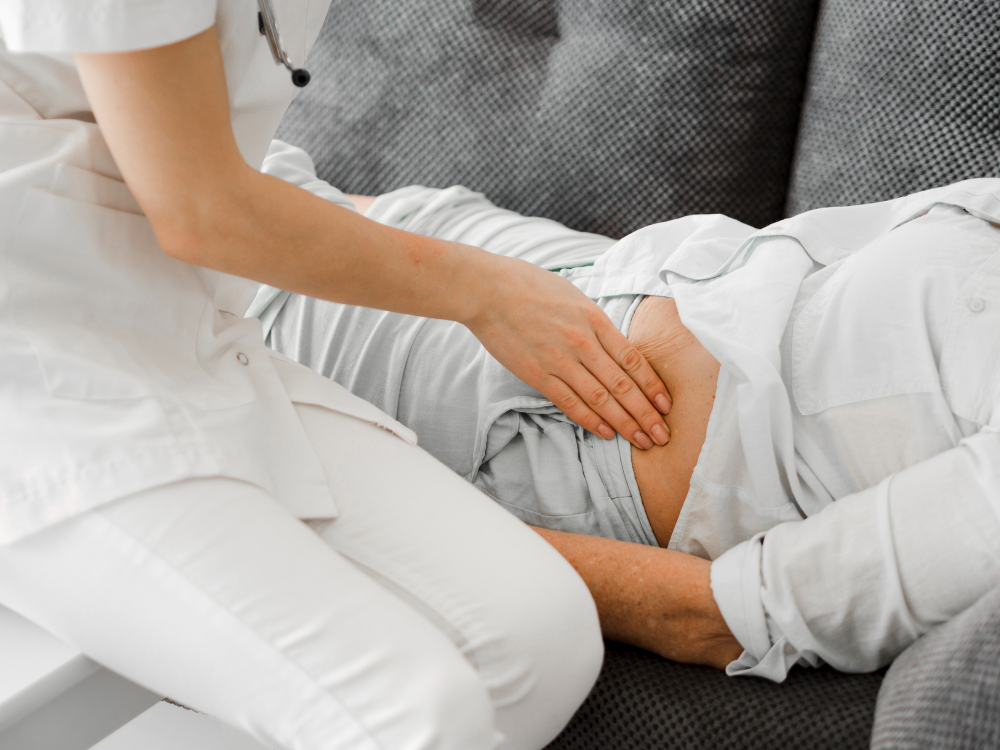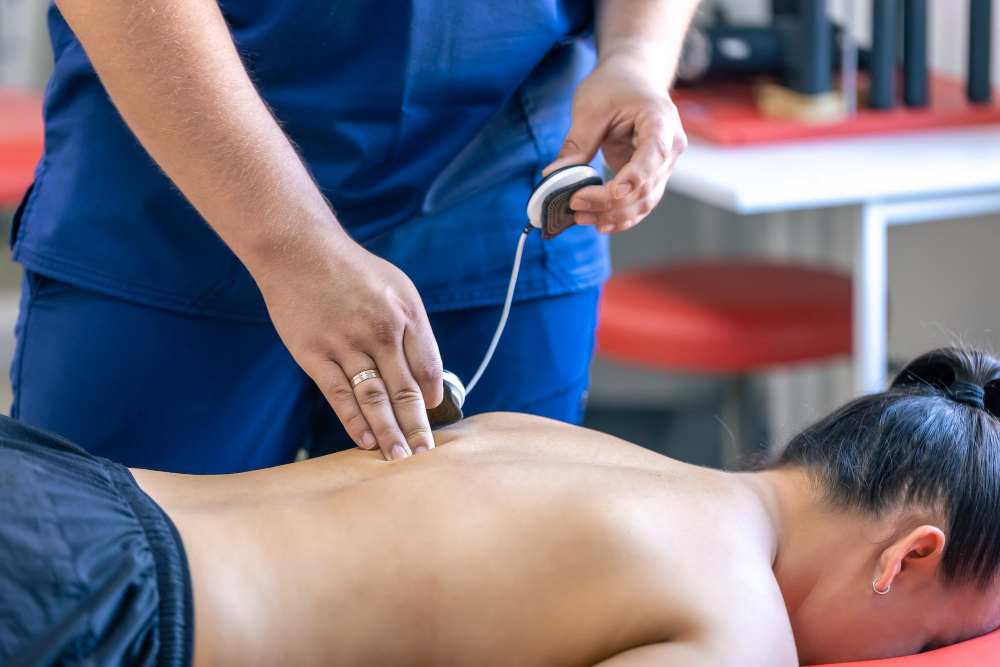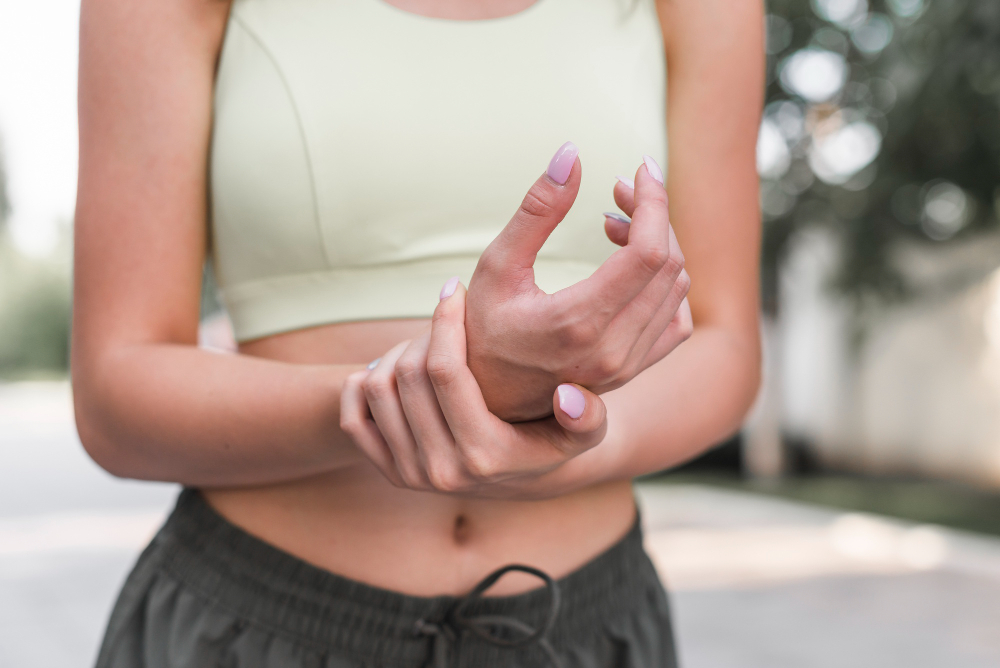Welcome to our comprehensive glossary of terms commonly used by physiotherapists and osteopaths! We have compiled this extensive list to provide you with a better understanding of the terminology you may encounter during your appointments. Whether you’re seeking treatment, curious about a specific condition, or simply interested in expanding your understanding, this glossary aims to explain these terms.
A
- Acupuncture: A technique that involves inserting thin needles into specific points on the body to stimulate natural healing and pain relief.
- Alignment: The position and arrangement of the body parts in relation to each other.
- Active Range of Motion: The movement produced by an individual’s own muscular effort, without assistance.
- Acute: A condition or injury that has a sudden onset and is of short duration.
- Arthritis: Inflammation of one or more joints, causing pain, stiffness, and reduced mobility.
B
- Balance: The ability to maintain the body’s centre of mass over its base of support, promoting stability.
- Biomechanics: The study of the mechanics of the human body, including the forces and movements involved in various activities.
- Bracing: The use of supportive devices, such as braces or splints, to provide stability and protection to injured joints or muscles.
- Body Mechanics: The use of correct posture, alignment, and movement patterns to perform tasks with minimal strain on the body.
C
- Chronic: Persisting or recurring over a long period.
- Core Stability: The ability of the muscles in the torso to support and control the spine and pelvis, providing a stable base for movement.
- Cryotherapy: The therapeutic use of cold, such as ice packs or ice baths, to reduce inflammation and pain.
- Cardiorespiratory Fitness: The ability of the cardiovascular and respiratory systems to efficiently supply oxygen and nutrients to the muscles during physical activity.
- Cartilage: A tough, flexible connective tissue found at the ends of bones, providing cushioning and facilitating smooth joint movement.
- Chronic Pain: Persistent pain that lasts for an extended period, typically more than three months.
- Contracture: A condition characterised by the permanent shortening or tightening of muscles or other tissues, limiting joint mobility.
- Crepitus: A crackling or grinding sensation or sound that occurs when moving a joint, often associated with conditions such as osteoarthritis.
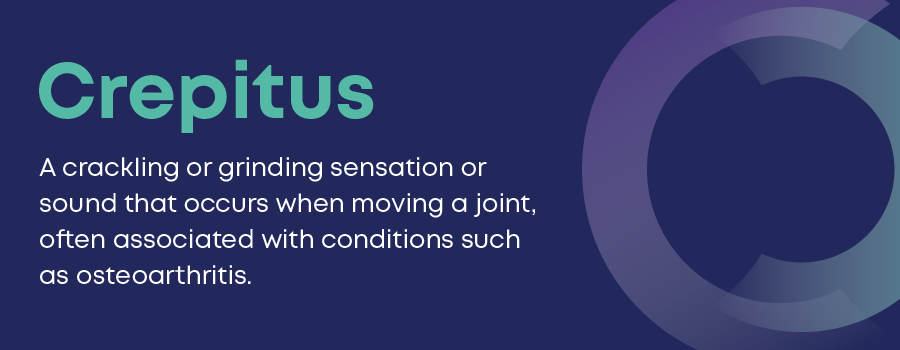
D
- Deep Tissue Massage: A massage technique that targets the deeper layers of muscles and connective tissues to relieve chronic muscle tension and promote relaxation.
- Dry Needling: A technique that involves inserting fine needles into trigger points within muscles to release tension and alleviate pain.
- Degeneration: The gradual deterioration or breakdown of tissues or structures, often associated with ageing or certain conditions.
- Disc Herniation: The protrusion or rupture of an intervertebral disc, resulting in compression of nearby nerves and causing pain and other symptoms.
- Dizziness: A sensation of lightheadedness or unsteadiness, often accompanied by a spinning or swaying feeling.
E
- Exercise Prescription: Tailored exercises and physical activities prescribed by a physiotherapist or osteopath to address specific conditions, promote recovery, or improve overall function.
- Electrotherapy: The therapeutic use of electrical stimulation to promote pain relief, muscle contraction, tissue healing, or other physiological effects.
- Ergonomics: The study of how to design and arrange workspaces, equipment, and tasks to optimise efficiency, comfort, and safety.
- Exercise Rehabilitation: The use of specific exercises and physical activities to help restore function, strength, and mobility following an injury, surgery, or illness.
F
- Fascia: A connective tissue that surrounds and supports muscles, bones, and organs, helping to maintain their shape and integrity.
- Flexibility: The ability of joints and muscles to move through their full range of motion.
- Fibromyalgia: A chronic disorder characterised by widespread musculoskeletal pain, fatigue, and tenderness in specific areas.
- Functional Movement: The ability to perform daily tasks and activities with proper biomechanics, coordination, and efficiency.
- Functional Rehabilitation: A treatment approach that focuses on improving functional abilities and movement patterns rather than just treating symptoms.
G
- Gait: The pattern of movement when walking or running, including stride length, step width, and timing of movements.
- Geriatric Rehabilitation: Specialised rehabilitation programs and therapies designed to address the specific needs and challenges of older adults.
- Graston Technique: A manual therapy technique that uses specially designed instruments to detect and treat soft tissue restrictions and scar tissue.
H
- Hydrotherapy: A form of therapy that involves exercises or treatments performed in water to aid rehabilitation, relieve pain, or improve mobility.
- Heat Therapy: The therapeutic use of heat, such as hot packs or warm baths, to promote muscle relaxation, increase blood flow, and relieve pain.
- Hydrotherapy: A form of therapy that involves exercises or treatments performed in water to aid rehabilitation, relieve pain, or improve mobility.
- Hyperextension: The excessive extension or backward bending of a joint or body part beyond its normal range of motion.
- Hypomobility: Reduced or restricted movement in a joint or body part, often due to injury, inflammation, or joint stiffness.
- Hypotonicity: Reduced muscle tone or low muscle tension, resulting in decreased resistance to passive movement.
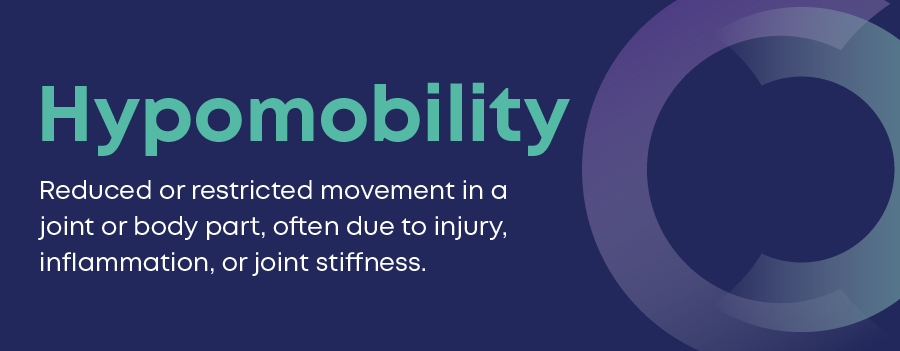
I
- Inflammation: A localised physical condition characterised by redness, swelling, heat, and pain, often as a response to injury or infection.
- Inversion: Inward movement of a body part, such as the foot or ankle.
- Isometric Exercise: Muscle contractions without joint movement, maintaining a static position to improve strength and stability.
J
- Joint Mobilisation: Manual techniques used by physiotherapists or osteopaths to gently move and stretch stiff or restricted joints to improve mobility and reduce pain.
- Joint Stabilisation: Exercises and techniques aimed at improving the strength and stability of a joint, often used in rehabilitation or injury prevention.
- Jumper’s Knee: Also known as patellar tendonitis, it is an overuse injury characterised by inflammation and pain in the patellar tendon, which connects the kneecap to the shinbone.
L
- Ligament: A tough band of fibrous connective tissue that connects bones or holds organs in place, providing stability and limiting excessive movement.
- Low Back Pain: Pain or discomfort in the lower region of the spine, commonly caused by muscle strain, disc problems, or poor posture.
- Lordosis: An inward curvature of the spine, typically in the lower back (lumbar lordosis) or the neck (cervical lordosis).
- Lumbago: Another term for low back pain, characterised by pain and discomfort in the lumbar region of the spine.
- Lumbar: Referring to the lower part of the spine, specifically the five vertebrae in the lower back (L1 to L5).
- Lymphedema: A condition characterised by swelling, usually in the arms or legs, due to a compromised or damaged lymphatic system.
M
- Manipulation: A hands-on technique employed by osteopaths to diagnose and treat musculoskeletal conditions by applying controlled forces to joints, bones, or soft tissues.
- Manual Therapy: Hands-on techniques, such as mobilizations, manipulations, or massage, used by physiotherapists and osteopaths to treat musculoskeletal conditions.
- Motor Control: The ability to coordinate and regulate muscular movements to perform precise tasks or activities.
- Muscle Imbalance: A condition in which certain muscles are overly tight or weak, leading to altered movement patterns and increased risk of injury.
- Myofascial Release: A therapy that involves applying gentle pressure to release tension and tightness in the fascia and muscles.
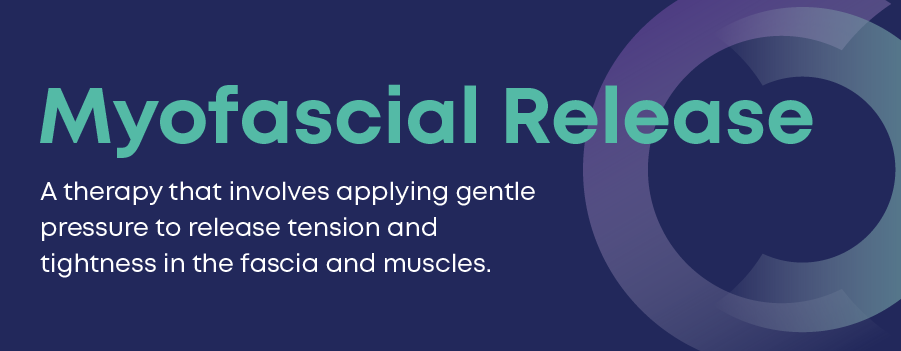
N
- Neurological: Relating to the nervous system and its disorders.
- Neuromuscular: Pertaining to the relationship between the nerves and muscles.
- Nerve Compression: The pressure or irritation of a nerve by surrounding structures, causing pain, tingling, numbness, or weakness.
- Neurodynamic Techniques: Specialised techniques used to assess and treat nerves and their mobility, promoting optimal nerve function.
O
- Orthosis: A device, such as a brace or splint, used to support, stabilise, or correct a part of the body.
- Orthopaedics: The branch of medicine that focuses on the prevention, diagnosis, and treatment of musculoskeletal disorders and injuries.
- Overuse Injury: An injury resulting from repetitive or excessive use of a particular body part, often associated with activities such as sports or repetitive motions at work.
- Osteoarthritis: The most common form of arthritis, characterized by the degeneration of joint cartilage and the underlying bone, resulting in pain, stiffness, and reduced range of motion.
- Osteopathy: A form of complementary medicine involving the treatment of medical disorders through the manipulation and massage of the skeleton and musculature.
- Osteoporosis: A condition characterised by low bone density and increased risk of fractures, often associated with ageing or hormonal changes.
- Overpronation: Excessive inward rolling of the foot during walking or running, often associated with flat feet and potential biomechanical issues.
P
- Posture: The position of the body and its alignment during rest and movement.
- Proprioception: The body’s ability to sense and perceive its position, movement, and force of muscles and joints.
- Passive Range of Motion: The movement achieved in a joint with the assistance of an external force, such as a therapist or equipment.
- Patella: The kneecap, a small bone located in front of the knee joint.
- Pelvic Floor: A group of muscles and connective tissues that support the pelvic organs and help control bladder and bowel functions.
- Proprioceptive Neuromuscular Facilitation (PNF): A technique that combines passive stretching and muscle contraction to improve flexibility and muscle function.
R
- Range of Motion: The extent of movement that can be achieved by a joint or a group of joints.
- Rehabilitation: The process of restoring function, strength, and mobility following an injury or illness.
- Rehabilitation Exercises: Therapeutic exercises prescribed to restore strength, flexibility, coordination, and function following an injury or surgery.
- Repetitive Strain Injury (RSI): An injury resulting from repeated, excessive stress or strain on a particular body part, typically associated with overuse or poor ergonomics.
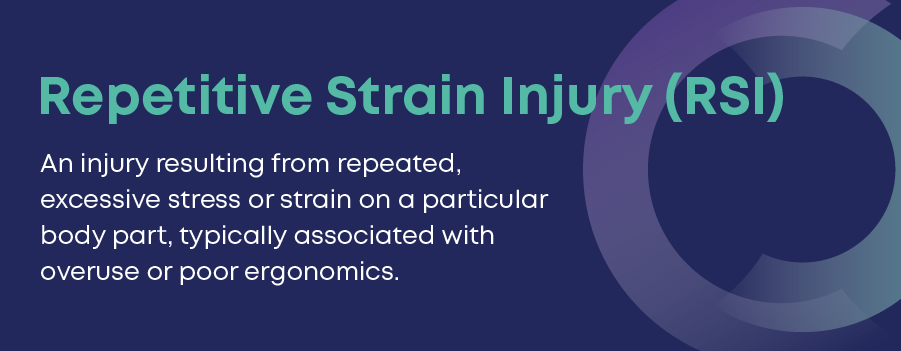
S
- Soft Tissue: The non-bony structures of the body, including muscles, tendons, ligaments, fascia, and skin.
- Spinal Manipulation: A technique used by osteopaths to apply controlled forces to the spine, aiming to improve mobility, relieve pain, and enhance overall function.
- Strain: An injury to a muscle or tendon, usually caused by overstretching or excessive use.
- Stress Fracture: A small crack or fracture in a bone that occurs due to repetitive stress or overuse.
- Sciatica: Pain that radiates along the sciatic nerve, typically felt from the lower back through the buttock and down the back of the leg.
- Spasm: Involuntary contraction or tightening of a muscle, often causing pain, stiffness, or muscle cramps.
- Sports Injury: An injury sustained during sports or athletic activities, ranging from minor sprains and strains to more severe fractures or dislocations.
- Stability Exercises: Exercises that focus on strengthening the core muscles and improving postural control to enhance stability and prevent injuries.
- Stress Management: Techniques and strategies to reduce and cope with physical and emotional stress, promoting overall well-being.
T
- Tendinitis: Inflammation of a tendon, often resulting from overuse or repetitive strain.
- Trigger Point: A specific area within a muscle that is tender and can cause pain when compressed or stimulated.
- Traction: The application of a pulling force to a body part or joint to relieve pressure, reduce pain, or promote proper alignment.
- Transcutaneous Electrical Nerve Stimulation (TENS): A therapy that uses low-voltage electrical currents to relieve pain by stimulating the nerves.
U
- Ultrasound Therapy: The use of high-frequency sound waves to promote tissue healing, reduce inflammation, and alleviate pain.
- Upper Crossed Syndrome: A postural imbalance characterised by tightness and weakness in specific muscles of the upper body, leading to rounded shoulders and forward head posture.
- Upper Extremity: Referring to the structures and functions of the arm, forearm, wrist, hand, and fingers.
- Unilateral: Affecting or relating to one side of the body or a single limb.
- Unstable Joint: A joint that lacks proper stability or control, often resulting from ligamentous laxity or muscle weakness.
- Upper Trapezius: One of the major muscles of the upper back and neck responsible for shoulder elevation and neck movement.
V
- Visceral: Pertaining to the internal organs and their relationships with the musculoskeletal system.
- Vertigo: A sensation of spinning or dizziness, often associated with inner ear problems or disorders affecting the vestibular system.
W
- Whiplash: A neck injury caused by a sudden forward and backward movement of the head, typically occurring in car accidents.
- Wellness: A state of optimal physical, mental, and emotional well-being, achieved through healthy lifestyle choices and self-care practices.
We hope that our glossary has helped you gain a better understanding of the terms frequently used by physiotherapists and osteopaths! If you have any further questions or need clarification, please don’t hesitate to contact us.


